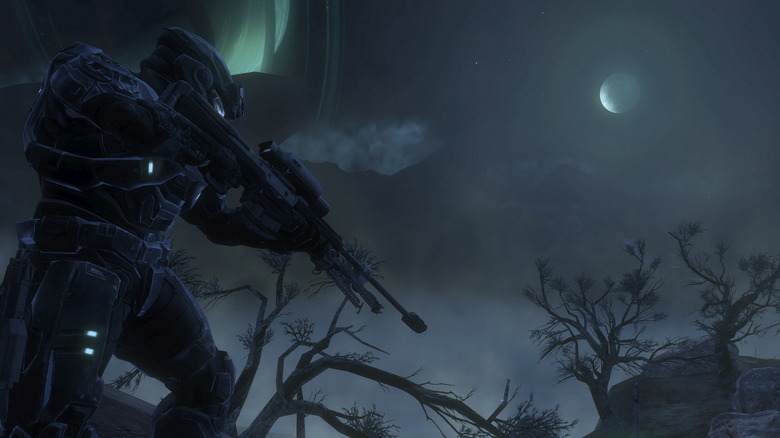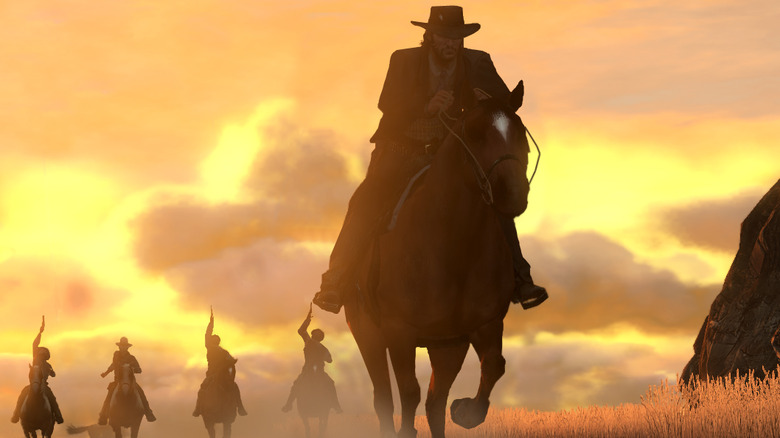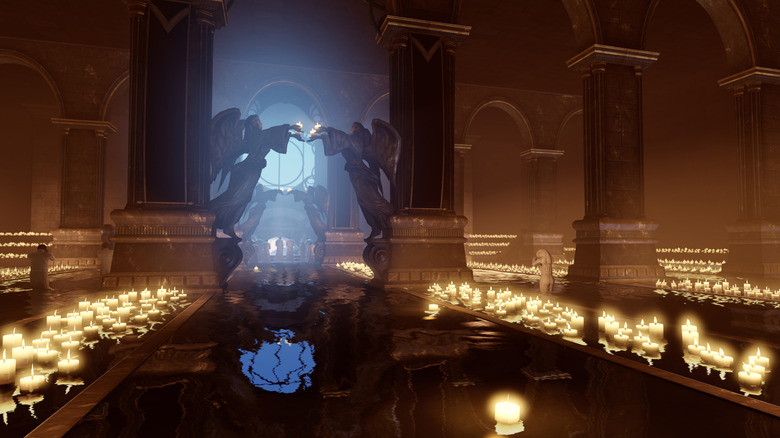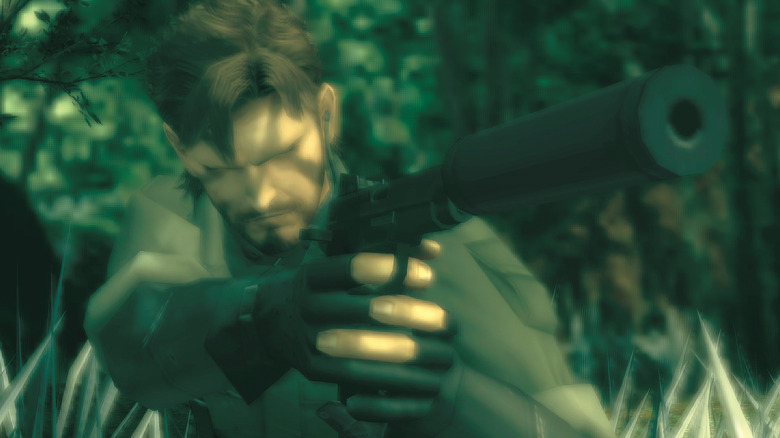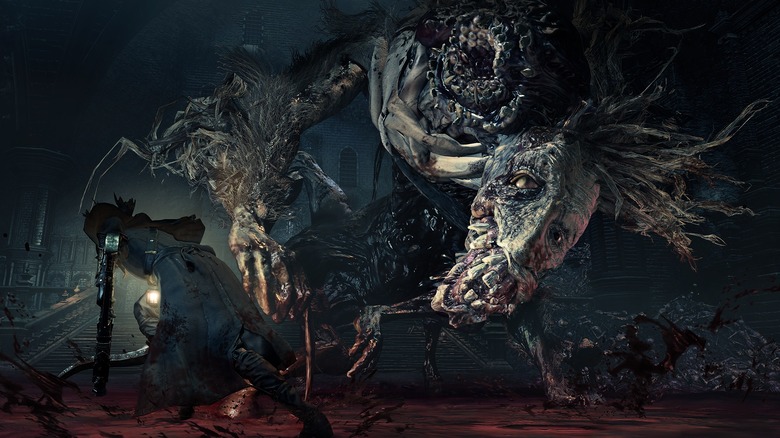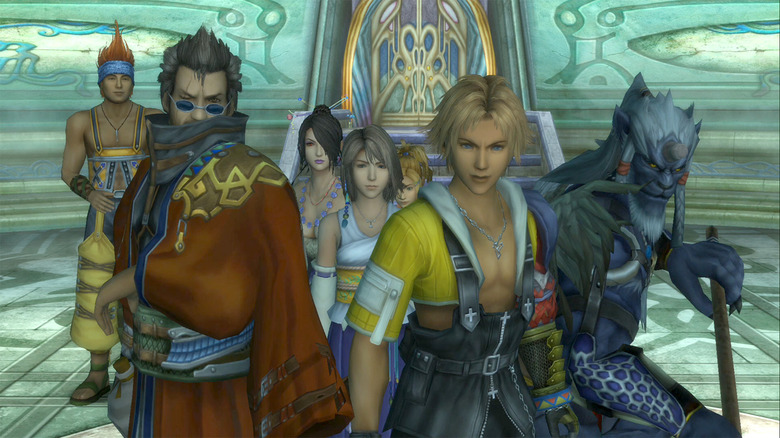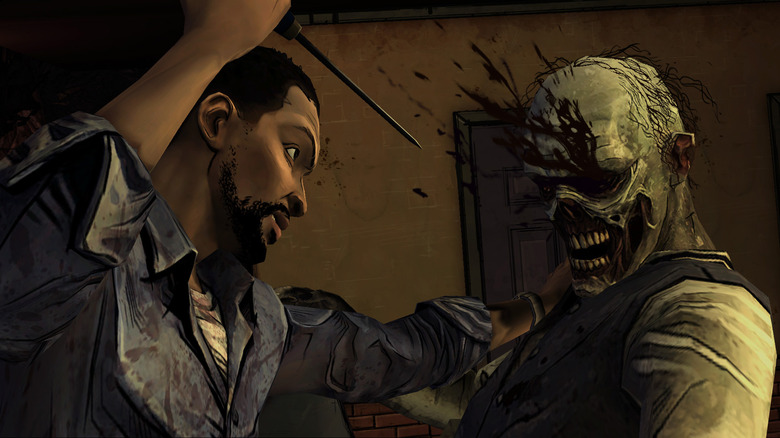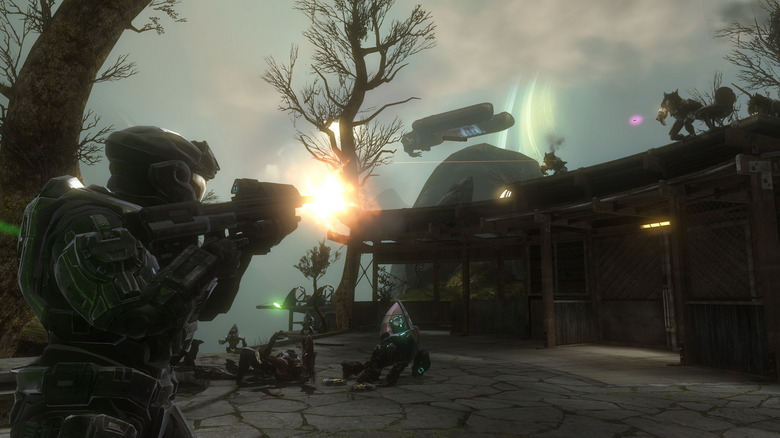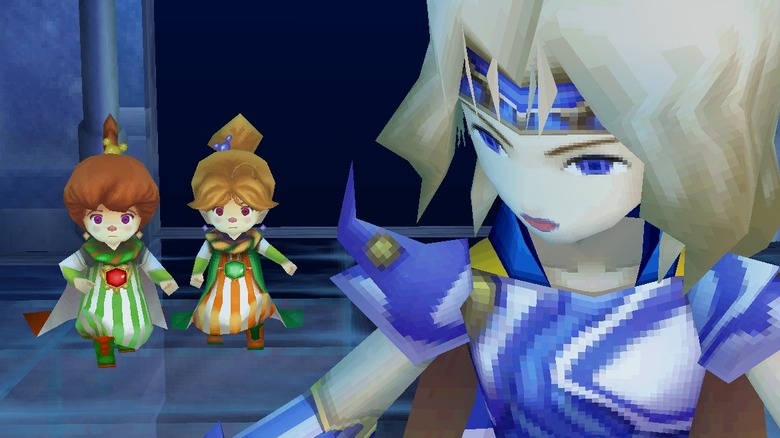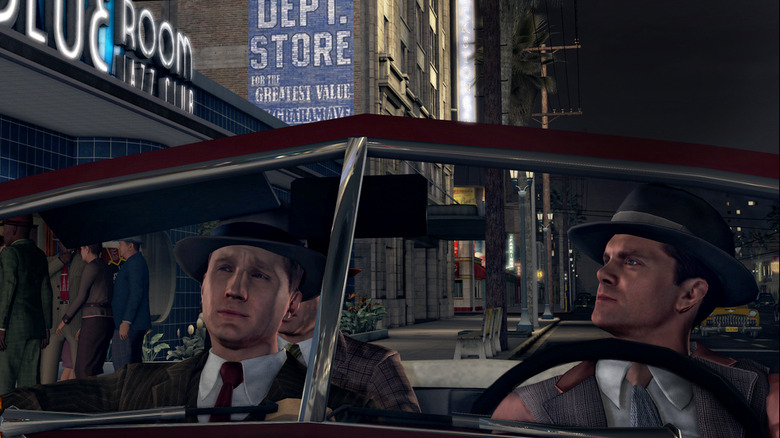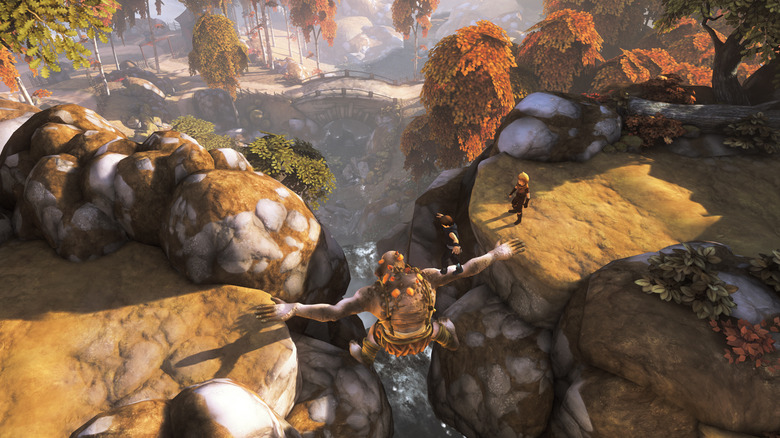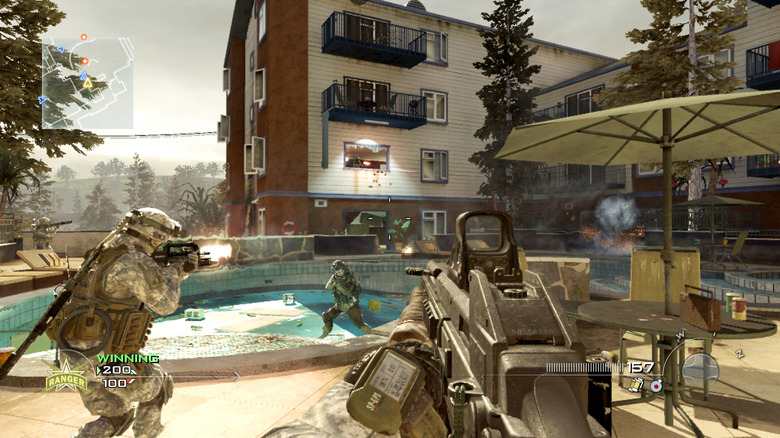Intense Gaming Moments Where You Were Forced To Die
As far back as most of us can remember, the goal of video games has boiled down to one simple concept: don't die. Whether your gaming reference point starts with "Don't let the Space Invaders blow up your ship," "Don't let Mario get touched by pretty much anything," or "Just be the last man standing," the general goal of most games is to keep your character alive.
That's why it can be so shocking when you're put into a situation where you cannot survive.
It goes against every fiber of our being when a video game puts us in a situation from which we are not intended to make it out alive. With some games, the main character's death plays as the cap to the storytelling — like the greatest tragic heroes, death is the only way their story can truly end. Other times, it introduces us to new mechanics or helps pass the torch along to another character's point of view. If done thoughtfully, killing off the player character can be one of the most effective items in the storytelling toolbox.
We're taking a look at some of the most surprising and intense moments where you had no choice but to let your character die. Grab your 1-Up before moving forward... you're gonna need it.
Red Dead Redemption stages a desperate final stand
Blessed be the peacemakers. Red Dead Redemption told quite a yarn, and its final story quest is one of the most impactful endings in recent memory. "The Last Enemy That Shall Be Destroyed" puts to rest the compelling story of John Marston, as shady government man Edgar Ross finally finishes him off. The way the mission plays out gives it the "oomph" needed to cap off Red Dead's sprawling narrative.
John's character arc is all about finding that titular redemption, and it seems he has at least achieved some semblance of it by turning over the members of his old gang and retiring to his ranch with his wife and son. Red Dead could never end on such a satisfying note, though — John's history is too checkered and his motivations too selfish. When the militia comes to call on Marston, he finally has a chance to earn what he seeks. By walking out the front door and confronting the gunmen, Marston is able to buy his family time to escape.
Entering Dead-Eye mode and engaging in a suicidal shootout with Ross and the soldiers is a fantastic final stand and a fitting end to Marston's story. It was so powerful that Kotaku even asserted that Red Dead Redemption 2 was wrong to tell a prequel story involving Marston's time with the Van der Linde gang. Of course, RDR2 turned out just fine.
BioShock Infinite has you die to save the multiverse
BioShock Infinite had pretty big shoes to fill. BioShock 2 is an underrated gem, but fans were still looking for a true follow-up to the original game's "Would you kindly?" reveal. BioShock Infinite swung for the fences by going all in on the "Infinite" aspect of its name, and it's an ending that has aged pretty well in the grand scheme of things.
In BioShock Infinite, players take on the role of Booker DeWitt, struggling to stop Zachary Comstock and his xenophobic followers from seizing control of reality itself. Comstock is portrayed as the ultimate villain — arrogant, powerful, and prophetic, he is the exact type of character you hate to be pitted against and can't wait to beat.
That's what makes BioShock Infinite's finale work so well. The ending is complex, but here's a Spark Notes version. When everything plays out, it turns out that Booker is Comstock from another reality, and the only way he can stop Comstock's rise is by going back in time and committing suicide. Booker chooses to prevent Comstock's existence by drowning himself during his baptism, causing an abrupt cut to black upon Comstock/Booker's death. Creepy.
Metal Gear Solid 3 shows the consequences of your murderous actions
The Metal Gear Solid series is known for several different things, but pretty much every gamer can agree that the games have a bizarre but fantastic story and some amazing boss fights. One of the most effective combinations of those is the battle with the Sorrow in Metal Gear Solid 3: Snake Eater.
Here's the setup: the Sorrow is the father of Ocelot, one of the most recognizable and irritatingly long-lived villains in the entire series. He is also dead for the entirety of MGS3. The player only encounters him after they also die, setting up a fascinating encounter in the river of death.
In a scene where the player must jump over a waterfall, protagonist Naked Snake doesn't survive the fall. But he awakens anyway in a burning river, where the ghost of the Sorrow taunts him. Every enemy the player has killed throughout the game throws themselves at Snake, meaning more pacifist players will have less to deal with. When the player finally catches the Sorrow, Snake dies yet again... but you can take a pill to wake Snake up, which is the only way to progress through.
It's a haunting scene and an interesting rumination on death in video games. MGS3 has a powerful and effective story to tell, and the Sorrow's role in things is a big part of that.
Bloodborne's first enemy tears you to shreds
The entirety of Bloodborne, the spiritual successor to Dark Souls, could probably qualify for this list — it's all pretty intense, and you're probably going to die a lot. The first boss, though, stands out. When you encounter the Cleric Beast, totally unarmed and unprepared, it is supposed to kill you to introduce the player to the Hunter's Dream. From there, the player is supposed to make their way back to the arena and fight back against the massive beast with some real equipment.
Technically, you can beat the Cleric Beast with your bare hands, in the same way that you can technically beat Dark Souls with a Guitar Hero controller. It can be done — that doesn't mean it will be done.
In fact, if you do somehow manage to take out the Cleric Beast without dying, you will have to find a place to die eventually — the Hunter's Dream is an essential spot to hit. It is a shocking moment nonetheless. The Cleric Beast is the first encounter in Bloodborne, and it tears most first-time players to shreds.
Final Fantasy X's last boss defends the dream
Similar to Metal Gear Solid, the storylines in Final Fantasy games can go big and go deep. Final Fantasy X was no exception, weaving together plenty of philosophical ideas across its massive narrative. We could probably write a doctoral dissertation on everything that happens in FFX, but here's the basic concept behind its tragic ending.
FFX is a story about the relationship between two central characters, Tidus and Yuna. Throughout the course of the game, you learn that Tidus is actually a dream/memory of a long dead person, given form by the Fayth, which are also spirits of the dead. Following along so far?
When the final boss is defeated, the Fayth lose their ability to exist in the mortal plane. Since Tidus is merely a dream of these spirits, defeating the final boss in FFX also means that the central character will lose his place in the world. It's bittersweet to watch Tidus and Yuna attempt to hug one another at the end of the game — since it's Final Fantasy, you've spent a LOT of time with these characters.
The Walking Dead: Season One delivers a gut punch worthy of the source material
Telltale really hit the nail on the head with their first season of The Walking Dead. Many of their later games were accused of being derivative (and the studio's surprising shutdown lends a bit of credence to the criticism surrounding them), but the story of Lee and Clementine was pretty remarkable. And, if you were at all familiar with the comics or television show the game was based on, you probably had a pretty good idea that things weren't going to turn out great for one (or both) of the main characters.
Do your choices in the game "matter" in the outcome of the story? Yes and no — Lee is always going to get bitten. But it affects the type of story the game tells, who the characters are, and what the player takes away from the ending. It's tough when you are given the option to put Lee out of his misery, but tough decisions are what The Walking Dead is all about.
Halo: Reach gives you a suicide mission to save the human race
Death is an inevitability in real life, and that inevitability is often one of the keys to telling a tragic tale. Not only was Halo: Reach a powerful prequel story in the already fascinating Halo universe, it was also Bungie's goodbye to the series as a whole. Halo: Reach closes out with a desperate final stand, featuring similar beats (and even a similar final shot) to the wonderful ending of Red Dead Redemption. It doesn't feel like your sacrifice is for nothing. It is entirely necessary to complete the story in a satisfying way.
Halo: Reach sees you take control of a soldier in the legendary Noble Team, and your central objective in the game is to give humanity a fighting chance against the ruthless Covenant forces. After achieving your team's goal and setting up events for the previously released Halo: Combat Evolved, there is one final epilogue mission to play through.
The game gives you a singular goal: survive. It becomes apparent pretty quickly that this simple direction is impossible, as bigger and bigger forces hit the ground and threaten to overrun your defenses. Your character, Noble Six, eventually falls in the battle. The scene even divided the Bungie staff before release, but it turned out to help tell a fantastic story that filled out the mythology of the Halo universe.
Final Fantasy II forces you to kill your evil past self
This one's sort of a "symbolic" death, but it still packs a punch. The "transformation" scene in Final Fantasy II (Final Fantasy IV in Japan) likely left many players confused as to how they were supposed to "kill" Cecil's Dark Knight form as the newly minted paladin version of the same character. Even with all the clues in the dialogue, our brains are wired differently when playing video games — we're not supposed to die.
Cecil battling against his past misdeeds and anger is a pretty impressive bit of storytelling for a creatively translated 16-bit RPG. Rather than fighting back, Paladin Cecil simply needs to absorb hits and defend himself, showing that he has transcended beyond his anger and has what it takes to battle against Golbez. In doing so, he is able to "kill" his former self and continue his adventure as a brand new man. For its time, it's a pretty deep plot twist that forces the player to rewire how they've tackled battles up to that point.
L.A. Noire delivers a true noir ending
L.A. Noire was a bit ahead of its time. We've seen plenty of film noir stories in, well, film, but to put a video game player into the shoes of a totally flawed and unlikable protagonist like Cole Phelps meant taking some serious storytelling risks that alienated a lot of players.
Retrospectives on L.A. Noire cast a much more favorable light on the game. Kotaku sums it up nicely, stating that Phelps' death was inevitable: "He's in way too deep to avoid drowning."
The most shocking aspect of Phelps' death is how pointless it all seems. His story has already begun to wind down, as he has been demoted to the arson unit by the time the final curtain falls. Even the villain in the final showdown is a character who was created directly due to Phelps' mistakes and trust in a corrupt system. It may come as quite a shock to many players when Phelps dies rescuing an old friend, but that's kind of the ultimate theme to the game's story: we aren't always the hero we think we are.
Brothers: A Tale of Two Sons makes powerful use of gameplay mechanics
Brothers: A Tale of Two Sons tells a powerful story despite its short runtime, and its unique mechanics help to drive home the impact of its final moments. Polygon writes that the developers didn't even intend for it to be a "puzzle game" in the traditional sense — it is meant solely to be a storytelling experience, and the ending packs quite an emotional punch.
Brothers tasks you with controlling two characters at once, with each analog stick on the controller moving one of the characters. Throughout the game, you are taught to rely on this sense of teamwork, and it becomes difficult to imagine completing certain tasks without both characters being involved.
When one of the brothers dies near the game's end, tasks that were once simple become seemingly insurmountable. In an exceptionally powerful moment, however, using the memory of the missing brother (by still using the left stick, as you once did) allows the surviving one to swim, something he has been unable to do on his own up to this point in the game.
It's a small moment, gameplay-wise, but it shows the impact that effective mechanics can have on telling a powerful story.
Call of Duty: Modern Warfare 2 courts controversy
Call of Duty may have shed its cinematic single-player mode in Black Ops 4, but the CoD franchise helped to reshape the shooter as we know it. Modern Warfare 2 played a big role in this — its two big deaths helped shape the overarching story of the series for several games, and one of those deaths is also part of a hugely controversial element in the Call of Duty timeline.
The controversy surrounds a mission entitled "No Russian." In it, you play as an undercover American agent working with Russian superterrorist Vladimir Makarov. You participate in walking through an airport, gunning down hordes of unarmed civilians. It's such a disturbing moment that the game even offers to let you skip it. The idea is that you're trying to earn Makarov's trust, but it's all for naught. Makarov knows you are a double agent and kills you as soon as the massacre is complete, with the event eventually leading to the Russian-American war.
Even more impactful is the turncoat Shepherd, who kills fan favorite characters Ghost and Roach. It shows Shepherd's true colors as a co-conspirator of Makarov's, and is especially painful because of how difficult (and plot-pivotal) the mission is leading up to Shepherd's betrayal. It gives the player plenty of drive to make it through the final few missions to take revenge on their former commanding officer.

